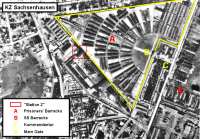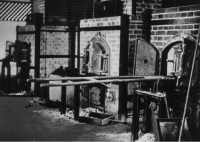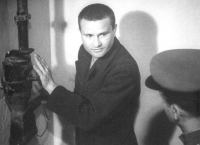 |
| Overview |
 |
| The Crematory "Station Z" * |
In
autumn 1941 the so-called "
Musterlager" (model camp)
Sachsenhausen, a few km away north of
Berlin, was
already the scene of some gassings in conjunction with the development of gas vans. From
December 1941 until May 1942 a crematory was built within
which a stationary gas chamber was later integrated.
The gas chamber was part of the so-called
"
Station Z" which was situated at the north-western
border of the camp. The name "
Station Z" resulted from the fact that the tower above the entrance
gate was named "A". The SS made a macabre joke; if the entrance was “A”, the first point, then the
exit (the crematorium) was “Z” – the last.
The L-shaped, one storey building contained four stationary ovens, a shot-in-the-neck installation, and later a
small gas chamber. About 600 corpses could be cremated in the ovens within 24 hours.
Although the building was located outside the camp and separated by a high wall, the site was recognizable because
of its chimney.
 |
| Remnants of the Gas Chamber |
In
1943 the very small gas chamber was installed. Commandant
Anton Kaindl testified that he was ordered by
Richard Glücks (Inspector of the KZs)
to build the gas chamber in
1942,
and that he did so in
autumn 1943. In contrast,
Paul
Sakowski testified that the gas chamber already existed in
1942.
The room was tiled and equipped with real showers. Besides the door was a ventilation system
for the insertion of the liquid Zyklon B, which was delivered in small bottles and kept in a locked wall cupboard
in the earth bunker near the shooting pit besides the building. A bottle was crushed with a spike to release
the gas. Then, together with warm air (to speed up the effect), it was introduced into the gas chamber.
In order to camouflage it as a bath room the gas chamber contained 6 showers.
It measured 2.5 x 3.5 metres. 25 - 30 persons
could be crammed in together. The victims had to undress in a small room and were then led into the gas chamber.
Besides the door was a glass peephole. After the introduction of the gas, it took only a few minutes until the victims
were dead. Then the ventilation fans were switched on and after a short time the corpses were pulled out by the
Krematoriumskommando.
Many persons were brought to Sachsenhausen to be executed. They were mostly shot or hanged, but in a few cases
were gassed.
Such a case was subject of trials at the district courts in
Verden and
Düsseldorf:
Kaindl's former adjutant,
SS-Untersturmführer
Heinrich Otto Wessel, was brought to trial in
Verden where the gassing of 8 - 10 foreign workers ("
Fremdarbeiter")
and up to 35 "
Ostarbeiterinnen" (female workers from the East) was considered. These killings were also
the subject of a hearing at the district court in
Düsseldorf in
1960 where
SS-Obersturmführer
August Höhn*
and
Otto Wilhelm Böhme were the accused. The foreign workers were gassed in
November 1944 because they had been accused of looting following an air raid. The
female workers were killed in
late 1944 or early 1945, for reasons unknown.
Smaller scale gassings, carried out solely by the SS, also happened. The last gassings occurred shortly before the
camp was evacuated. As had earlier been the case in
Ravensbrück,
the so-called "Moll-Kommando"
was active again. In
late 1944 commander
Kaindl
ordered the
Auschwitz-experienced
Otto Moll to kill prisoners who were no longer able to walk.
Moll had already served at Sachsenhausen, e.g. as chief of the gardener-command.
In
1941 he was ordered to the command staff at
Auschwitz.
As in
Ravensbrück most of the sick prisoners were shot or (in some cases)
sent to the gas chamber. How many prisoners were killed is unknown but witnesses mention up to 4,000 victims.
 |
| Demonstration of the Gas Tap * |
In the course of the evacuation of the camp, all of the technical installations of the gas chamber were dismantled. Later
parts were found by the Soviets at the site of the former industrial premises and re-installed for demonstration purposes.
This happened during preparations for the trial which took place at the town hall of
Pankow.
The crematory building, which was completely intact when the camp was liberated, was blown up by
the GDR
Volkspolizei in
1952/53. Only when the Sachsenhausen memorial was
planned in the
early 1960s, were remnants of the foundations and ovens were
found and saved. The problematic nature of this part of the memorial during the existence of the GDR has been
replaced by a more suitable arrangement during recent years.
It is not known exactly how many people died in the gas chamber, or how often it was used.
Sakowski stated 35 gassings.
Photos:
Gedenkstätte Sachsenhausen
*
USHMM *
GFH *
Sources:
Sachsenhausen. Dokumente, Aussagen, Forschungsergebnisse und Erlebnisse über
das ehemalige Konzentrationslager Sachsenhausen. VEB Deutscher Verlag der Wissenschaften, Berlin 1986
Kogon et al.:
Nationalsozialistische Massentötungen durch Giftgas. Frankfurt/M. 1986
Morsch, Günter (Hrsg.):
Mord und Massenmord im Konzentrationslager Sachsenhausen 1936-1945. Berlin 2005
© ARC 2006











